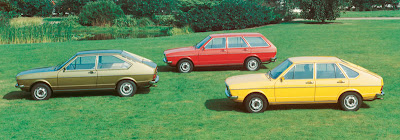VW Golf I, 1974




The first Golf began production in 1974. Marketed in the United States and Canada from 1975 to 1984 as the Volkswagen Rabbit and in Latin America as the Volkswagen Caribe, it featured the water-cooled, front wheel drive design pioneered by the Citroën Traction Avant in 1934 with the addition of a hatchback pioneered by the Renault 4 in 1961. The Golf was Wheels magazine's Car of the Year for 1975. The name is short for Golf-Strom, German for Gulf Stream; it was named for that oceanic current to reflect its international character. It was originally named the Rabbit in North America and the Caribe in Latin America, ironically, because marketers decided that no one in the Western Hemisphere would understand the European name.
While the Golf was not the first design with this layout (earlier examples being the Austin and Morris Mini of 1959, the Austin Maxi in the late 1960s and the Fiat 128 3P of the early 1970s), it was very successful, especially since it married these features with Volkswagen's reputation for solid build-quality and reliable engineering.
The Golf was designed by Italian automobile architect / designer Giorgetto Giugiaro, of the ItalDesign design studio. A version of this original Golf model, known as the Volkswagen CitiGolf, is still produced in South Africa as an entry level car.
In 1978, Volkswagen commenced producing the Rabbit version of the Mk1 Golf in Westmoreland County, Pennsylvania, thus becoming the first European car manufacturer in modern times to produce a vehicle in the United States. Former Chevrolet executive James McLernon was chosen to run the factory, which was built to lower the cost of the Rabbit in North America by producing it locally. Unfortunately, McLernon tried to "Americanize" the Rabbit by softening the suspension and using cheaper materials for the interior. VW purists in America and company executives in Germany were displeased, and for the 1983 model year the Pennsylvania plant went back to using stiffer shocks and suspension with higher-quality interior trim. The plant also began producing the GTI for the North American market. (Rabbits were built in Pennsylvania through 1984.) The first VW Caddy pick-up, based on the Mk1 Golf, was also created at the Pennsylvania plant.
The GTI version, launched in Europe in 1976 and in the US in 1983, virtually created the hot hatch genre overnight, and many other manufacturers since have created special sports models of their regular volume selling small hatchbacks. It was one of the first small cars to adopt fuel injection for its sports version, which raised power output of the 1588 cc engine to 110 PS (81 kW/108 hp). In 2004, Sports Car International announced the GTI Mk I as the 3rd best car of the 1980s. In the United States, the Mk1 Golf GTI was known as the Rabbit GTI.
There was a minor facelift in 1980 for North American versions only, which saw the adoption of larger rear lamp clusters (more in line with Guigiaro's original concepts), larger bumpers, square headlights and a new dashboard with a more modern-looking instrument display.
The convertible version, named the Cabriolet, was sold from 1980 to 1993 (a convertible version of the Golf II was not made, so the Mk1 cabrio with slight modification was produced until the introduction of the Mk III cabrio). It had a reinforced body, transverse roll bar, and a high level of trim. The A1 Volkswagen convertible is of unibody construction built entirely at the factory of Karmann, from stamping to final assembly; Volkswagen supplied the engine, suspension, interior, etc. for Karmann to install. The vinyl tops were insulated and manually operated, with a glass rear window.
As of 2006, Volkswagen of South Africa still manufactures two first generation Golfs, the four-door "Citi" Golf and the "Pickup".









